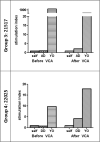Immunomodulatory Strategies Directed Toward Tolerance of Vascularized Composite Allografts
- PMID: 25757218
- PMCID: PMC4551576
- DOI: 10.1097/TP.0000000000000681
Immunomodulatory Strategies Directed Toward Tolerance of Vascularized Composite Allografts
Abstract
Background: Achieving tolerance of vascularized composite allografts (VCAs) would improve the risk-to-benefit ratio in patients who undergo this life-enhancing, though not lifesaving, transplant. Kidney cotransplantation along with a short course of high-dose immunosuppression enables tolerance of heart allografts across a full major histocompatibility complex (MHC) mismatch. In this study, we investigated whether tolerance of VCAs across full MHC disparities could be achieved in animals already tolerant of heart and kidney allografts.
Methods: Miniature swine that were tolerant of heart and/or kidney allografts long term underwent transplantation of myocutaneous VCA across the same MHC barrier. Before VCA transplant, group 1 (n = 3) underwent class I-mismatched kidney transplantation; group 2 (n = 3) underwent 2 sequential class I-mismatched kidney transplantations; group 3 (n = 2) underwent haploidentical MHC-mismatched heart/kidney transplantation; and group 4 (n = 2) underwent full MHC-mismatched heart/kidney transplantation.
Results: All 3 animals in group 1 and 2 of 3 animals in group 2 showed skin rejection within 85 days; 1 animal in group 2 showed prolonged skin survival longer than 200 days. Animals in groups 3 and 4 showed skin rejection within 30 days and regained in vitro evidence of donor responsiveness.
Conclusions: This is the first preclinical study in which hearts, kidneys, and VCAs have been transplanted into the same recipient. Despite VCA rejection, tolerance of heart and kidney allografts was maintained. These results suggest that regulatory tolerance of skin is possible but not generally achieved by the same level of immunomodulation that is capable of inducing tolerance of heart and kidney allografts. Achieving tolerance of skin may require additional immunomodulatory therapies.
Figures






Similar articles
-
Vascularized composite allograft transplant survival in miniature swine: is MHC tolerance sufficient for acceptance of epidermis?Transplantation. 2013 Dec 15;96(11):966-74. doi: 10.1097/TP.0b013e3182a579d0. Transplantation. 2013. PMID: 24056624 Free PMC article.
-
The Effect of MHC Antigen Matching Between Donors and Recipients on Skin Tolerance of Vascularized Composite Allografts.Am J Transplant. 2017 Jul;17(7):1729-1741. doi: 10.1111/ajt.14189. Epub 2017 Feb 8. Am J Transplant. 2017. PMID: 28035752
-
Induction of cardiac allograft tolerance across a full MHC barrier in miniature swine by donor kidney cotransplantation.Am J Transplant. 2013 Oct;13(10):2558-66. doi: 10.1111/ajt.12423. Epub 2013 Aug 22. Am J Transplant. 2013. PMID: 24033991 Free PMC article.
-
Effect of major histocompatibility complex matching on the development of tolerance to primarily vascularized renal allografts: a study in miniature swine.Hum Immunol. 1996 Sep 15;50(1):1-10. doi: 10.1016/0198-8859(96)00059-6. Hum Immunol. 1996. PMID: 8872170 Review.
-
The MHC-characterized Miniature Swine: Lessons Learned From a 40-Year Experience in Transplantation.Transplantation. 2022 May 1;106(5):928-937. doi: 10.1097/TP.0000000000003977. Epub 2021 Oct 29. Transplantation. 2022. PMID: 34720103 Review.
Cited by
-
Utility of IL-2 Complexes in Promoting the Survival of Murine Orthotopic Forelimb Vascularized Composite Allografts.Transplantation. 2018 Jan;102(1):70-78. doi: 10.1097/TP.0000000000001852. Transplantation. 2018. PMID: 29272255 Free PMC article.
-
Accommodation and related conditions in vascularized composite allografts.Curr Opin Organ Transplant. 2017 Oct;22(5):470-476. doi: 10.1097/MOT.0000000000000446. Curr Opin Organ Transplant. 2017. PMID: 28682798 Free PMC article. Review.
-
Immune Tolerance, Xenografts, and Large-Animal Studies in Transplantation.Ann Am Thorac Soc. 2017 Sep;14(Supplement_3):S220-S225. doi: 10.1513/AnnalsATS.201607-534MG. Ann Am Thorac Soc. 2017. PMID: 28945472 Free PMC article.
-
The combination of mitomycin-induced blood cells with a temporary treatment of ciclosporin A prolongs allograft survival in vascularized composite allotransplantation.Langenbecks Arch Surg. 2018 Feb;403(1):83-92. doi: 10.1007/s00423-017-1616-3. Epub 2017 Aug 19. Langenbecks Arch Surg. 2018. PMID: 28823033
References
-
- Pribaz JJ, Caterson EJ. Evolution and limitations of conventional autologous reconstruction of the head and neck. J Craniofac Surg. 2013;24:99–107. - PubMed
-
- Shanmugarajah K, Hettiaratchy S, Clarke A, Butler PE. Clinical outcomes of facial transplantation: a review. Int J Surg. 2011;9:600–607. - PubMed
-
- Khalifian S, Brazio PS, Mohan R, et al. Facial transplantation: the first 9 years. Lancet. 2014 - PubMed
-
- Petruzzo P, Dubernard JM. The International Registry on Hand and Composite Tissue allotransplantation. Clin Transpl. 2011:247–253. - PubMed
Publication types
MeSH terms
Grants and funding
LinkOut - more resources
Full Text Sources
Research Materials

